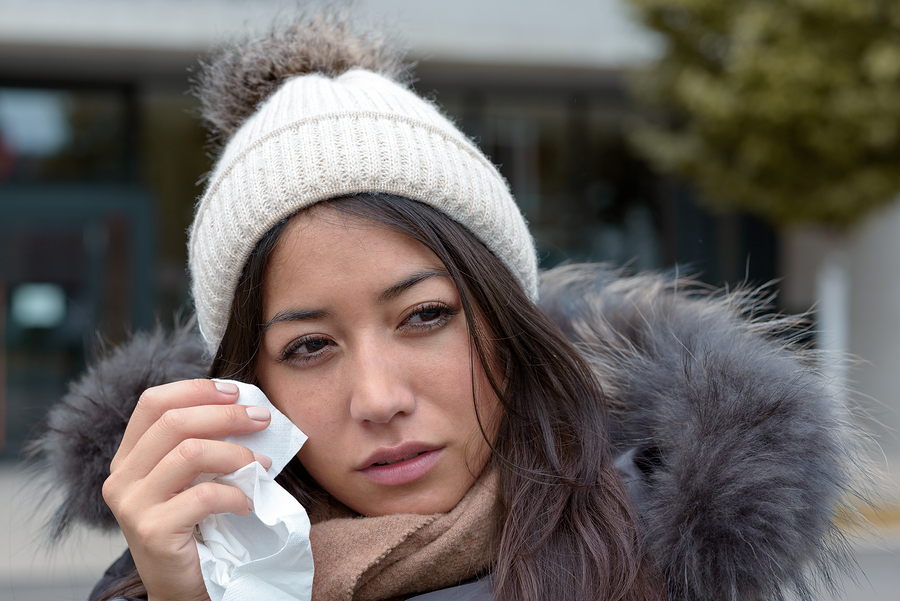
Dry Eye Syndrome is a common, often chronic, condition that can cause lots of discomfort. Dr. Harriette Canellos, the director of the UEC’s Referral Service and associate clinical professor at SUNY College of Optometry, explains:
What is dry eye?
Dry Eye Syndrome is a common and often chronic condition that affects approximately 25-30 million people in the US. It can affect any race, and tends to be more common in women than in men.
Dry eye results from decreased tear production, poor tear quality or sometimes a combination of the two. Tears are formed by glands that surround the eye and the tear film is composed of three layers: oil, water and mucous which all help to lubricate and nourish the front surface of the eye. Tears also help flush out dust and debris, provide protection from infection and help provide clear vision. Symptoms of dry eye can occur, as mentioned earlier, if a person doesn’t have enough tears or if the tear film quality is poor, as well as if the tear film evaporates too quickly.
Dry eye can cause discomfort and visual disruption and it can sometimes cause inflammation and damage to the ocular surface.
Dry Eye Disease is also sometimes referred to as Ocular Surface Disease or Keratoconjunctivitis Sicca.
What are some of the symptoms of dry eye?
People with Dry Eye Syndrome may experience dryness, burning, redness, irritation or a tired feeling in their eyes. They may also feel a gritty, sandy or scratchy sensation or have blurred vision or excess tearing.
What causes dry eye?
There are many causes of dry eye. It tends to increase with age, affecting people who are over 40 more often. Women are more likely to experience dryness due to hormonal changes, pregnancy, menopause and the use of oral contraceptives. Conditions of the eyelids, such as blepharitis and meibomian gland dysfunction, can also contribute to excessive evaporation of the tear film. Contact lens wearers also tend to suffer from dry eye more often. Refractive surgical procedures such as LASIK, PRK and LASEK can also cause dry eye, along with certain medications that can reduce tear production such as decongestants, antihistamines, antidepressants and certain blood pressure medications. Certain systemic conditions are associated with dry eye, such as Sjogren’s Syndrome, rosacea, lupus, rheumatoid arthritis, thyroid dysfunction, diabetes and other autoimmune disorders. People with allergies also tend to suffer from dry eye.
Environmental conditions such as air conditioning, heaters, sun, wind, dry climates and exposure to smoke can increase tear evaporation. Computer use, prolonged reading and TV viewing also contribute to dry eyes. With each blink, the eyelid spreads a thin film of tears over the front surface of the eye so when we stare at a computer or TV screen, or read for long periods of time, we don’t blink as much as we should. This causes the tear film to evaporate more quickly.
People who suffer from severe dry eye are at an increased risk for eye infections and damage to the ocular surface which can significantly affect vision. Whatever its cause, dry eye can often negatively impact the quality of a person’s life.
How is dry eye treated?
There are multiple ways to manage dry eye but it’s important to recognize that the management of the condition depends on what’s causing it which your doctor will assess before coming up with a treatment plan.
Mild dry eye is often managed with over-the-counter artificial tear drops, gels and ointments. It is important to discuss with your doctor which artificial tears are recommended and how often to use them.
Prescription eye drops may be recommended to help increase the production of tears and decrease inflammation in the eye. Your doctor may also recommend omega-3 fatty acid nutritional supplements.
Another option in managing dry eye can be with a simple in office procedure. Plugs are inserted into tiny openings in the lids which help drain the tears. These plugs keep the tears from draining and the keep the eyes moist. They can also be removed if needed.
Treating the underlying cause of the dryness is very important. For example, if eyes are dry due to eyelid inflammation, the eyelids will need to be treated as well. Warm compresses, lid massage and eyelid cleansers are often used. Your doctor may also prescribe drops, gels or ointments such as antibiotics and mild steroids.
You may also be able to reduce your dry eye symptoms by adjusting your environment. For example, a humidifier can add moisture to dry indoor air in the winter time. Eyeglass shields and wrap around glasses can help prevent wind from getting into the eyes. Moisture chamber glasses or goggles may be used to retain moisture and also protect the eye from dust, smoke and other irritants.
If eyes are dry mainly while reading, using the computer or watching TV, taking frequent breaks and blinking more regularly can help.
If your dry eye syndrome is caused by an underlying medical condition, your eye doctor and primary care physician or a specialist can work together to make sure that these conditions are appropriately treated.
If you have symptoms of dry eye, it is important to see your optometrist for evaluation and treatment.
 Dr. Harriette Canellos is the director of the Referral Service at the University Eye Center and instructor of record for the fourth-year internship program as well as associate clinical professor at SUNY College of Optometry.
Dr. Harriette Canellos is the director of the Referral Service at the University Eye Center and instructor of record for the fourth-year internship program as well as associate clinical professor at SUNY College of Optometry.
To schedule an appointment call (212) 938-4001 or click here